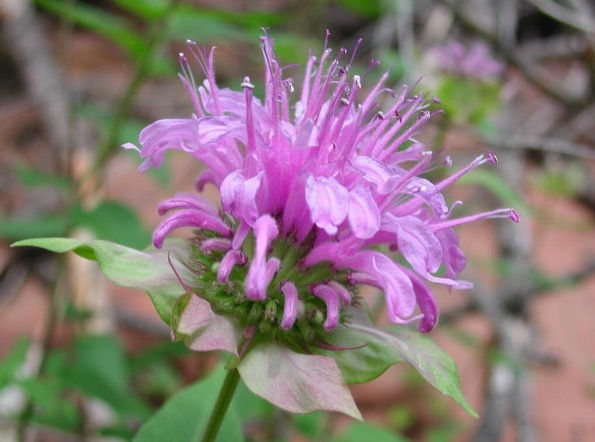Bee Balm: Fiery, Fragrant & Fiercely Supportive
- Jodi McKee
- May 25, 2023
- 4 min read
Updated: Jul 23
Latin Name: Monarda fistulosa (Lamiaceae)
Herb Class/Action: Carminative, Diaphoretic, Antiseptic, Stimulant, Expectorant, Emmenagogue
Parts Used: Leaves, Flowers
Flavors: Aromatic, Bitter, Spicy
Energetics: Warming, Diffusive
Traditional Benefits: Immune support, fever support, digestive system support, respiratory support

Bee Balm (Monarda spp.) is one of those herbs you can smell before you see it — vibrant, wild, and unapologetically spicy. Found growing across much of North America, this perennial powerhouse has long been used by Native American tribes like the Cherokee, Cheyenne, and Lakota for its medicinal and culinary gifts.
Whether you call it Bee Balm, Wild Bergamot, or Wild Oregano, this mint-family plant is anything but mellow. It brings the heat, both in flavor and in its action on the body.
Meet Bee Balm: The Wild Mint with a Kick
A proud Lamiaceae (mint) family member, Bee Balm stands out with its fiery red to deep purple blossoms, attracting bees, butterflies, and herbalists alike. It can grow up to five feet tall, with vibrant flowering heads that light up your garden and serve as an excellent clue to its “warming” herbal nature.
Unlike most of its minty cousins, Bee Balm isn’t cooling—it’s warming, diffusive, and bold. Thanks to its high content of volatile oils, which give it both its sharp, thyme-like flavor and its potent antimicrobial properties, it's been lovingly dubbed “wild oregano.”
Immune-Boosting, Antiseptic & Diffusive Action
When you feel a cold coming on, Bee Balm is the herb you want standing by with a metaphorical sword. Its diffusive action helps break up stagnation in the body, moving heat, clearing stuck mucus, and stimulating circulation. Take a hot infusion and you’ll feel that warmth almost instantly. It’s like lighting a tiny herbal fire in your chest (in the best possible way).
Bee Balm is:
Diaphoretic – Encourages sweating to help break a fever and cool the body
Antiseptic – Thanks to potent volatile oils like thymol and carvacrol
Expectorant – Loosens stuck mucus and helps clear the respiratory tract
Immunostimulant – Gently supports the immune system in doing its job efficiently
This is a go-to herb for cold and flu season, particularly when symptoms are cold, clammy, and sluggish—think wet socks, congestion, chills, and overall heaviness. Bee Balm helps move the body into a more active, responsive state, clearing out the cobwebs and waking up the system.
Bee Balm for Digestion & Detoxification
Beyond its bold immune magic, Bee Balm shines as a carminative—that is, an herb that supports digestion by easing gas, bloating, and cramps. It’s especially beneficial when your gut is feeling cold, heavy, or stagnant.
Helpful for:
Gas, bloating, colic, and cramping
Gallbladder congestion and sluggish digestion
Nausea, heartburn, constipation, and mild diarrhea
Cold digestion (white-coated tongue, feeling of cold in the belly)
Energetically warming and toning the solar plexus organs—the stomach, liver, gallbladder, and intestines—Bee Balm also has a subtle nervine action, helping to calm digestive upset tied to stress or emotional overload.
It’s also considered alterative, meaning it gently supports detoxification by aiding the liver and improving elimination. Some herbalists even call on Bee Balm to soothe hangovers or support gut repair in cases of leaky gut syndrome — not a cure-all, but indeed a helpful ally.
Soothing Steams, Infusions & Herbal Honey
Bee Balm’s bold personality means a little goes a long way. On its own, it can be a bit intense for some palates, so blending it with gentler herbs like chamomile, lemon balm, or elderflower can help round out its flavor and effect.
Ways to Use Bee Balm:
Hot tea (infusion): Especially helpful during the onset of a cold or flu
Tincture: Useful for digestive or immune formulas
Infused honey: An herbal cough syrup that’s as tasty as it is effective
Steam inhalation: Clears congestion and uplifts the senses
Culinary herb: Use it like oregano or thyme in savory dishes!
Bee Balm also makes a lovely addition to first-aid formulas for its antiseptic qualities, and the fresh flowers are edible — beautiful tossed into salads or infused into vinegars for a spicy floral zing.
Final Thoughts: Fierce, Functional, and Floral
Bee Balm doesn’t tiptoe in — it bursts onto the scene, full of aroma, action, and herbal charisma. It warms the body, clears the head, soothes the gut, and lights up the immune system — all while looking like a fireworks display in the garden.
Whether you steep it, tincture it, or let it mingle with raw honey, Bee Balm is a plant worth knowing, growing, and having on hand—especially when cold season creeps in or your digestive fire needs a little stoking.
Want to grow Bee Balm and other medicinal plants in your garden?
📗 Grab my ebook Harvest & Herb: A Modern Medicinal Garden for tips on planting, harvesting, and using your herbal allies with confidence.
The information offered on HealWise websites is for educational purposes only. HealWise makes neither medical claims nor is it intended to diagnose or treat medical conditions. Links to external sites are for informational purposes only. HealWise neither endorses them nor is in any way responsible for their content. Readers must do their own research concerning the safety and usage of any herbs or supplements.
.jpg)



Comments